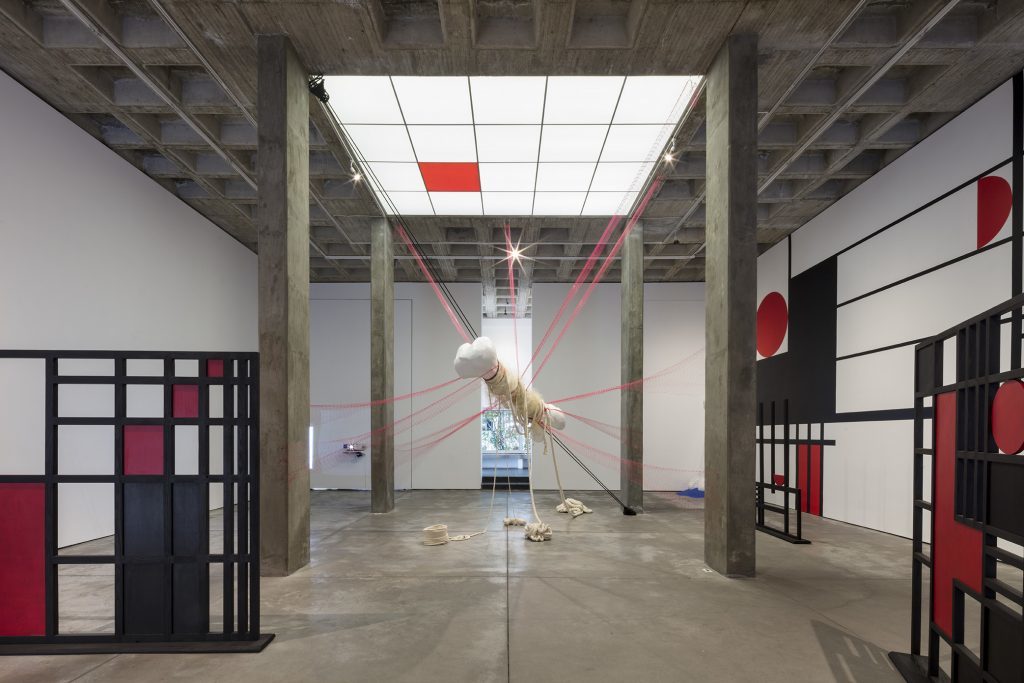
View of Julieta Aranda’s exhibition “Ghost Nets,” 2018, showing (center) Infrastructure:
Meeting the Universe Halfway, 2018, fiberglass, ropes, and fishnets, dimensions variable,
at OMR Gallery, Mexico City, Mexico.
“Ghost fishing” describes a highly destructive phenomenon that is activated when fishing nets get detached from their vessels and begin catching fish, coral reefs and other forms of marine life autonomously. As a consequence, entire ecosystems are being wiped out, and if left unattended, ghost nets will keep on fishing on their own for the next several centuries. This phenomenon is one of the narratives behind Julieta Aranda’s (b. Mexico City, 1975, b. in Berlin) installation Ghost Nets at the OMR Gallery in Mexico City in the Spring of 2018. At the center of the gallery, we encounter a gigantic bone suspended from the ceiling by nylon nets and bound to the floor by three bundles of ropes. The bone is surrounded by uneven red, white and black grid structures. The structures are made out of unfolded cubes whose six faces we can see in a same plane, inspired by patterns made out of relationships between words and the shapes of cross-words puzzles and intervened by circles and semi-circles (I cannot avoid to think about Aranda deconstructing the minimalist cube, the basic element aesthetic language in Western art since the 1960s). Some of these structures hang from the ceiling, others are directly painted on the gallery’s walls; some ceramic versions of the grids hang in the walls, while others stand freely on the ground. This arrangement is interspersed by smaller bones leaning on the walls or resting on colored sand. The installation is presided by a giant cross-word puzzle woven as a rug on the wall we confront when entering the gallery space. In the text about the installation, curator Chus Martínez compares bones to the white cube: we usually think that both are dull but necessary. The raw matter of bones, however, is osteolacin, a protein that plays a crucial role in regulating sugar and thus our memory and mood, Marínez’s text informs us. In other words, bones not only hold the structure of our bodies but carry out and preserve our memories and are responsible for our emotions. From this we can infer a series of analogies unfolding in the juxtaposition of the elements that conform Aranda’s installation: bones, like the ghost fishing nets, have autonomous agency and so do the human-made structures that give shape to our world. The grids, like the cross-world puzzle, store and structure things and words, in a similar way than sand and ice preserve traces of life within them (Martínez also lets us know that Aranda wishes us to imagine the installation as under water), as do arrangements of pixels that constitute images in permanent flux on the net, traces of which we see in Aranda’s installation on a screen on the right side to the main bone.
Our understanding of the world is Modern and that means that it is based on frameworks that structure human organization politically, philosophically, socially and epistemologically. Since these frameworks are abstract, our understanding of the world is based on a division between theory and practice, which implies that matter (bodies, land) is abstracted into epistemological spaces for our understanding. Aranda’s series of analogies between bones and grids and pixels and cubes and ghost nets, however, open up toward a fresh and necessary understanding of agency: as circulating relationally in both human and non-human worlds. That is to say, structures within our bodies and our world both play a role in creating and maintaining societies. Everyone and everything has a memory, agency and life, and this implies enabling us to undo the dichotomies of abstraction and embodiment, human and non-human, organic and inert, inside and outside. The agency of sand and ice in preserving life is the same as bones, grids and nets. Clearly, although Western societies are built upon domination over nature, humans are not above nature and things: inert structures are also part of societies and have agency over them. Agency may not include consciousness or thought but it is located in relations between individuals, everyone and everything over which we have obligations and responsibilities. We are thus not only responsible for stopping destruction of the ghost fishing nets roaming the oceans, but but to the epistemological, social and economic structures that created them in the first place.
Irmgard Emmelhainz